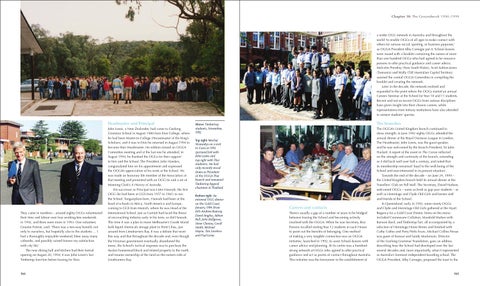Light Blue Generations: A History of The Old Geelong Grammarians
Chapter 10: The Groundwork 1990–1999
a wider OGG network in Australia and throughout the world ‘to enable OGGs of all ages to make contact with others for various social, sporting, or business purposes,’ as OGGA President Alby Carnegie put it. School-leavers were issued with a booklet containing the names of more than one hundred OGGs who had agreed to be resource persons to offer practical guidance and career advice. Malcolm Priestley (New South Wales), Scott Ashton-Jones (Tasmania) and Wally Cliff (Australian Capital Territory) assisted the central OGGA Committee in compiling the booklet and creating the network. Later in the decade, the network evolved and expanded to the point where the OGGs started an annual Careers Seminar at the School for Year 10 and 11 students. Recent and not-so-recent OGGs from various disciplines have given insight into their chosen careers, while representatives from tertiary institutions have also attended to answer students’ queries.
Headmaster and Principal
They came in numbers – around eighty OGGs volunteered their time and labour over four working-bee weekends in 1992, and there were more in 1993. One volunteer, Graeme Fenton, said: ‘There was a two-way benefit, not only to ourselves, but hopefully also to the students … I had a thoroughly enjoyable weekend, blew away many cobwebs, and possibly ruined forever my satisfaction with city life.’ The new dining hall and kitchen had their formal opening on August 20, 1994; it was John Lewis’s last Timbertop function before leaving for Eton.
164
John Lewis, a New Zealander, had come to Geelong Grammar School in August 1980 from Eton College, where he had been Master-in-College (Housemaster of the King’s Scholars), and it was to Eton he returned in August 1994 to become their Headmaster. He seldom missed an OGGA Committee meeting and at the last one he attended, in August 1994, he thanked the OGGs for their support to him and the School. The President, John Hawkes, congratulated him on his appointment and expressed the OGGA’s appreciation of his work at the School. He was made an honorary life member of the Association at that meeting and presented with an OGG tie and a set of Manning Clark’s A History of Australia. His successor as Principal was Lister Hannah, the first OGG (he had been at GGS from 1957 to 1961) to run the School. Tanganyikan-born, Hannah had been at the head of schools in Africa, North America and Europe, coming to GGS from Munich, where he was Head of the International School. Just as Garnett had faced the threat of encroaching industry early in his term, so did Hannah. This time it was a plan to move Melbourne’s Coode Island bulk liquid chemicals storage plant to Point Lilias, just around from Limeburners Bay. It was a debate that went this way and that throughout the decade and, even though the Victorian government eventually abandoned the move, the School’s tactical response was to purchase the Avalon homestead block and related property to the north, and resume ownership of the land on the eastern side of Limeburners Bay.
The branches
Above: Timbertop students, November, 1992. Top right: Mechai Viravaidya on a visit to Corio in 1993 (pictured left with John Lewis and top right with Thai students). He had only recently stood down as President of the OGGA Thai branch and remained Timbertop Appeal chairman in Thailand. Bottom right: An informal OGG dinner on the Gold Coast, January, 1994 (from left) Andrew Ramsay, David Angliss, Adrian Bell, John Bellgrove, Steve Cheney, Geoff Smith, Michael Hayne, Tim Loveless and Paul Lister.
Careers and contacts There’s usually a gap of a number of years to be bridged between leaving the School and becoming actively involved with the OGGA. When he was Secretary, Boz Parsons recalled visiting Year 12 students in each House to point out the benefits of belonging. One method of making a very tangible connection was an OGGA initiative, launched in 1992, to assist School-leavers with career advice and planning. At its centre was a hundredstrong network of OGGs who agreed to offer practical guidance and act as points of contact throughout Australia. This initiative was the forerunner to the establishment of
The OGGA’s United Kingdom branch continued to show strength; in June 1992 eighty OGGs attended the annual dinner at the Royal Overseas League in London. The Headmaster, John Lewis, was the guest speaker, and he was welcomed by the branch President, Sir John Hackett. A report of the event in The Corian reflected on the strength and continuity of the branch, extending as it did back well over half a century, and noted that its membership remained ‘loyal to the well-being of the School and ever-interested in its present situation’. Towards the end of the decade – on June 24, 1999 – the United Kingdom branch held its annual dinner at the Travellers’ Club on Pall Mall. The Secretary, David Hudson, welcomed OGGs – some as fresh as gap year students – as well as Hermitage and Clyde Old Girls and former staff and friends of the School. In Queensland, early in 1992, some ninety OGGs and Clyde and Hermitage Old Girls gathered at the Hyatt Regency for a Gold Coast Dinner. Items on the menu included Connewarre Collation, Manifold Mutton with Barwon Basil, and Timbertop Tart, all accompanied by a selection of Hermitage Home Brews and finished with Cuthy Coffee and Perry Petits Fours. Michael Collins Persse was guest of honour and Sandy Mackenzie, Director of the Geelong Grammar Foundation, gave an address describing how the School had developed over the last several decades and, more importantly, what it represented as Australia’s foremost independent boarding school. The OGGA President, Alby Carnegie, proposed the toast to the
165
